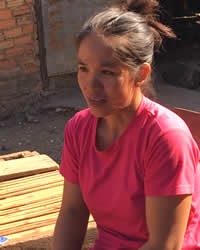Saek in Laos

Photo Source:
Anonymous
|
Send Joshua Project a map of this people group.
|
| People Name: | Saek |
| Country: | Laos |
| 10/40 Window: | Yes |
| Population: | 6,800 |
| World Population: | 27,800 |
| Primary Language: | Saek |
| Primary Religion: | Ethnic Religions |
| Christian Adherents: | 0.20 % |
| Evangelicals: | 0.20 % |
| Scripture: | Translation Started |
| Ministry Resources: | No |
| Jesus Film: | No |
| Audio Recordings: | Yes |
| People Cluster: | Tai |
| Affinity Bloc: | Southeast Asian Peoples |
| Progress Level: |
|
Introduction / History
Because of ceaseless Chinese pressure, the Tai speaking tribes emigrated south from China, conquering many peoples along the way. By the thirteenth century, they had made their way to Laos and Thailand.
The Saek (Tai Sek) live along both sides of the Mekong River in central Laos. There is also a community of Saek people living in northeastern Thailand near the Vietnam border. The Saek speak a Diac language, called Saek, which belongs to the northern Tai branch. Many also speak Lao and Thai.
What Are Their Lives Like?
Through extensive contact, the Saek (like other tribes), have been assimilated into Lao and Thai culture. Almost every aspect of Saek society reflects their assimilation into these dominant cultures. However, the famous "round dances" of the Saek women remain one of the unique characteristics of their culture. They also have their own language, Saek, though it is related to many other languages in their region.
Saek homes are made of wood or bamboo. They are built on stilts. The family's livestock (mainly poultry, pigs and goats) run freely underneath the houses. Farmlands are next to the residential areas. While rice is the chief crop of the Saek, they also raise a wide variety of crops for consumption and trade. Fishing and hunting are also important activities. The Saek remain in frequent contact with the Lao and the Thai by bartering goods such as meat and vegetables for clothing and salt.
The Saek depend on the monsoon rainfall to water their fields. Men clear the fields for planting, build houses, fish, and hunt. The women weed the fields, help with the harvest and carry on most of the trading. Very few of the Saek have moved to the cities.
The most significant political unit in Saek society is the village. Each village is independent from the others and has a headman who decides on important issues. The nuclear family, headed by the father, is also a vital part of the Saek culture. Intermarriage with the So in Laos is a common practice within Saek society.
What Are Their Beliefs?
The Saek people are officially Buddhist, but animistic beliefs dominate their daily activities. The spirit world terrifies them. If a family member passes away inside a Saek home, they will sometimes completely abandon the house, afraid that the lingering spirit will incessantly torment them. These spirits are based on the forces of nature. The Saek people make offerings to these spirits because they believe this will prevent sicknesses. Their villages do this on a larger scale by honoring a guardian spirit.
What Are Their Needs?
The Saek people need to find their way to the cross and the empty grave. They need to put their faith in the loving Father, not in destructive spirits.
Prayer Points
Pray for Saek people in Thailand and Laos to have open and receptive hearts, and that they would encounter the King of kings.
Pray that movements to Christ would explode, as followers make followers, and that they would place their identity in Christ.
Ask God to raise up prayer teams who will begin breaking up the spiritual soil through worship and intercession.
Ask the Lord to bring forth a vigorous Saek church for the glory of his name!